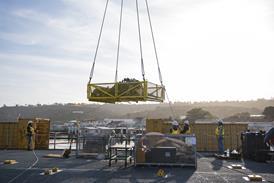Andrew Doyle/MUNICH Guy Norris/LOS ANGELES

Leasing companies General Electric Capital Aviation Services (GECAS) and International Lease Finance (ILFC) have dropped their combined orders for seven Boeing 767-400ERs after failing to find sufficient market interest in the stretched twins.
ILFC says it has switched its four remaining -400ER commitments for the smaller -300ER, while Boeing confirms that GECAS is substituting other models for its three orders.
"We weren't getting a lot of enquiries or requests for -400ERs," says ILFC assistant vice-president marketing, Marty Olson. "We haven't seen the demand."
Los Angeles-based ILFC originally ordered five of the type as part of a larger Boeing deal in September 1997, but changed one to a -300ER in June last year for placement with Air New Zealand.
Olson says, however, that ILFC retains the right to change them back to the -400ERshould a customer materialise. He adds that the company is continuing to experience strong demand in the important European charter market for leased 757-200s and 767-300ERs.
The 767-400ER, which is in flight testing, was developed to counter the strong-selling Airbus A330-200, but has so far been ordered by only two airlines - Continental and Delta - with 26 and 21 aircraft, respectively. Continental cut its orderbook from 30 to 26 in March 1998.
Despite the model's relatively slow start, Boeing claims it is confident that sales will pick up. "Airlines continue to show interest and we are actively working several proposals," it says. Boeing predicts that a significant portion of the market for the 767-400ER will develop over the next few years in the Asia-Pacific region.
Although much of the expected market is on routes which do not require further range, Boeing is studying a longer-range -400ERX to compete more directly with the Airbus A330-200 and boost its appeal to European charter airlines.
As the marketing battle continues, the second Boeing 767-400ER has joined the test programme, while the first aircraft has begun initial take-off performance and ground effects testing at Edwards AFB, California.
The initial aircraft has amassed more than 100h of flight tests, or roughly 25% of its expected contribution to the test programme. Certification is targeted for 13 April, 2000, with initial delivery to launch customer Delta Air Lines due the following month.
Following completion of the ground effects testing for automatic landing conditions at Edwards AFB, the first aircraft will begin more rigorous stability and control work, marking the start of Phase II of the "real test programme", says -400 test and validation chief engineer, Kenneth Kirwan.
Aircraft number two, in full Delta livery, will begin automatic landing tests almost immediately. The third airframe, which will mostly undergo cabin systems tests with a fully equipped interior, is due to fly on 16 December.
Source: Flight International























